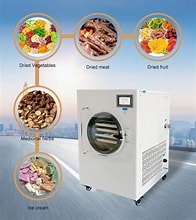
Freeze Drying, Modified Atmosphere Packaging (MAP) – Increased Shelf Storage Life, Increased Food Safety Risk
The increased cost of food makes it tempting to extend its shelf life. (Prior preparation also reduces labor and time at the point of service). Bacteria grow well in foods with oxygen, moisture, protein, warmth (between 41F and 135F), and a mild environment. This equation is often called FAT-TOM. The food service manager has immediate control over the food’s temperature and time at that temperature. Nevertheless, assuming they are done safely, many processes could influence the FAT-TOM equation.
Vacuum packaging removes oxygen, discouraging the growth of spoilage and vegetative (heat susceptible) bacteria. The use of dehydration and freeze drying remove moisture and some oxygen. Pickling and curing foods increase the acidity, discouraging bacterial growth.
These processes rely on labor-intensive processes using accurate and often expensive equipment. The equipment must be able to test for oxygen levels, dryness (water activity), and acidity (pH).
Foods must be from approved sources, portioned consistently for uniform processing, and prepared to avoid further contamination, both before and after processing. These processes require time and precision to be accurate and safe. Depending on the type of process, bacteria initially present in food shipments might not be destroyed but only discouraged from further growth. Therefore, the supplier is critical. Further, even after initial heating, the foods can be contaminated through unsafe food handling.
The preparation and recipes must be consistently followed and approved. Equipment must be capable of testing for oxygen levels, water activity, and acidity (pH), depending on the process. For this reason, commercial food kitchens are not allowed to use these processes without obtaining a variance and an approved HACCP plan.
• For instance, removing oxygen from foods discourages the growth of spoilage- and oxygen-loving bacteria but not others such as C. botulinum or Listeria monocytogenes. The latter survive in the absence of oxygen. The process must include heat treatment of foods to deactivate the latter bacteria before vacuum packaging.
• A dehydrator extracts moisture, resulting in food that appears dry but may still retain internal moisture. Insufficient heating of foods like raw beef, chicken, or fish can lead to a final product that isn’t shelf-stable, allowing bacteria to grow. Dehydrators only heat to 130-140F, not hot enough to destroy pathogen (disease-causing) bacteria such as Salmonella and E. Coli. The USDA Food Safety Inspection Service states there must be an initial cooking to required safe temperatures before placing into the dehydrator.
• Freeze drying removes moisture by freezing and vaporing it, not by a single heat drying step. Foods are frozen to -20 or -30F. (how many commercial kitchens have freezers like this?) They must be sliced thinly and uniformly to allow uniform drying. The frozen food is placed in a vacuum, and heat turns ice crystals into vapor. Then, heat is applied to remove any remaining moisture. Water activity must be lowered to below 0.6 pH to discourage the growth of microorganisms. Again this requires testing for water activity and acidity (pH)
What’s the difference between available moisture and water activity? why does it matter? Regulatory authorities are often interested in the latter value since it is relevant to the definition of TCS foods.
Available Moisture: Water bound to ingredients in the food such as salt, sugars, and protein. This water may or may not be available for bacteria to use.
Water Activity: The law says TCS foods have a water activity above 0.85. The water activity is the amount of moisture available for the growth of bacteria. It might not be equal to the amount of moisture in the food (moisture may be bound up and not available for bacteria to use).
It is often assumed that foods like watermelon will have a high water activity – while the available moisture is roughly 94% the water activity is .992 pretty much what is expected but not the same. Here are a few other foods with water activity (Aw) and Total Moisture – there are significant differences:
Food Total Moisture Water Activity (Aw)
Watermelon 94% .992 (read 99.2%)
Cocoa 7-10% .70
Peanut Butter 2% .70
Whole milk powder 7% .70
Dried Fruits 31% .60-.65
Peppers 92% .99
Broccoli 91% .99
Oranges 87% .99
Apples 84% .98
Chicken (raw) 69% .99
Beef (raw) 73% .99
Beef (cooked) 60% .98
Chicken (cooked) 62% .91-.98
Bread (commercial) 36% .94-.96
Beef jerky 23% Below 0.8
Jams/Preserves 30% .75-.80
Salami 60% .82
Of course, these values will vary depending on suppliers and the types of foods analyzed.
As always thank you for reading! Each article is written with a lot of research and I value your comments. Thanks – David
References:
‘Water Activity Values of Select Food Ingredients and Products’ Shelly J. Schmidt and Anthony J. Fontana, Jr. in onlinelibrary.wiley.com
‘Available Moisture in Foods: What Is It Anyway?’ Cooperative Extension College of Agriculture, Forestry and Life Sciences Clemson University Clemson.edu
‘Food Fundamentals and Chemistry ‘Understanding Moisture Content in Foods’ 12.16.23 Food Safety Institute
‘Jerky and Food Safety; USDA Food Safety and Inspection Service https://www.fsis.usda.gov/food-safety/safe-food-handling-and-preparation/meat-fish/jerky
‘At-home freeze drying: A growing trend with food safety concerns’ Jonan Pilet 2/24/2025 Food Safety News
